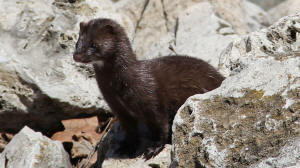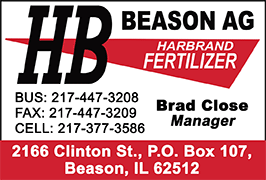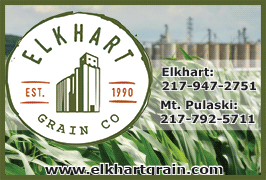Mink farming industry toes the line as Illinois lawmakers consider
regulations
[April 16, 2025]
By Jade Aubrey and UIS Public Affairs Reporting (PAR)
SPRINGFIELD — For over 65 years, Bernice and Frank Monteleone have been
raising minks on their farm in Elgin. The couple bought their first mink
in 1959 — a red female who was pregnant at the time. She quickly
produced seven babies, or kits.
“Before then, I had never seen a mink before in my life,” Bernice
Monteleone said.
The couple traded those kits for minks from a neighboring farmer and
began to breed them. That one female mink led the family to raise around
30,000 minks at the height of their production. In turn, the farm
financially supported all the couple’s children and their families
throughout the 1970s and 1980s.
“It has been a really wonderful way of life,” she said. “We’ve raised
six kids here and a bunch of grandkids, and they learned good work
habits and things like that from it, too. We really enjoyed that kind of
life.”
Although the industry has self-imposed guidelines farmers adhere to in
order to sell their pelts legally, mink farming is not regulated at the
federal level or in Illinois.
But a bill in play in Springfield could change that. House Bill 2627,
sponsored by Rep. Joyce Mason, D-Gurnee, would regulate the mink
industry at the state level, creating mink farm licensing and
requirements. But proponents and opponents have two vastly different
opinions on what the bill really aims to do.

Mason testified during the hearing alongside Chris Green, executive
director of the Animal Legal Defense Fund, and Marc Ayers, Illinois
director of the Humane Society of the United States, who all warned of
the potential public health risks mink farms pose.
But Bernice Monteleone and Challis Hobbs, executive director of Fur
Commission USA, disagree. They say the bill’s main goal is to ban the
mink industry, and that the requirements outlined in the bill are
impossible for farmers to adhere to.
“I don’t know if it’s ignorance, or if, in my opinion, it is them trying
to push us out of business,” Hobbs said in an interview. “Because these
same proponents tried to pass a bill last year to ban us, so that’s what
it looks like.”
What the bill would do
Hobbs and Monteleone’s opinion, the bill is yet another attempt to shut
the industry down.
“There’s not much doubt in my mind that they’re just trying to get rid
of it,” Hobbs said, referring to the mink farming industry. “When I read
these things and how they’ve written this bill, obviously, it’s not
someone who’s been in agriculture or they just want to put us out of
business.”
But Mason maintains the bill’s intention is to protect public health.
“This isn’t even about mink welfare, it’s about health,” Mason said in
an interview. “My goal is not to shut them down at all. It’s just to
make sure that they’re not breeding viruses.”
HB2627 is supported by the Animal Legal Defense Fund, the Humane Society
of the United States, and the Animal Welfare Institute. It is opposed by
such groups as the Fur Commission USA, the Illinois Farm Bureau, and the
Illinois Trappers Association.
The bill passed a House committee in March but was never called for a
vote in the full House before an April 11 deadline. However, if passed
into law, HB2627 would create a mink farming license, requiring farmers
to disclose their location, the number of staff they employ, and the
number of minks they house.
“To our knowledge, only four fur farms exist in this state, just four,”
bill proponent Marc Ayers, Illinois director of the Humane Society of
the United States, said in committee.

However, Monteleone said she’s not sure there are even that many fur
farms in the state.
“I’m not even aware of four, to be honest with you,” Monteleone said.
“We used to communicate quite a bit before, but the industry has gotten
much smaller.”
Hobbs said the transparency of farm locations poses a safety risk to
farmers. They say the locations of mink farms are kept relatively secret
on purpose – to protect both mink farmers and their animals from
anti-fur activists, who often break into farms and set caged minks free.
Hobbs said minks usually die within 24-48 hours of their release and
that activists have released over 50,000 commercially raised minks in
the past few years.
The bill also requires farmers to pay an annual license fee of $1,000,
which would be used for two annual inspections of mink farms, among
other things. It also sets several requirements that farmers must meet
if their minks show signs of infection.
One of those requirements would be that farmers test enough of their
minks weekly for COVID, bird flu or any other “potentially harmful
virus.” Farmers would also have to test all their staff for viruses as
well.
Those testing requirements, Hobbs said, would put a large financial
burden on small mink farmers. According to him, the industry voluntarily
participated in a national USDA program where they tested minks and farm
employees for viruses. Between the costs of labor and sample collection
from that program, they estimated the testing would cost farmers over
$160,000 per year.
If any of the minks or workers on a farm test positive, the bill would
require farmers to quarantine all their workers and separate their minks
from one another by six feet. Hobbs said this separation would be
“impossible” to achieve on any commercial farm – as commercially raised
minks live in rows of small wire cages, placed side by side.
“They want you to separate the mink six feet apart. You can’t. There’s
no livestock where you can do that,” Hobbs said. “I promise you, if this
bill was proposed for any other industry, you’d have every powerful
lobbyist group there in two seconds, because the regulations on this are
crazy.”

Another provision would mandate that farmers euthanize their minks “if
euthanasia of the mink is necessary for disease containment.” Currently,
poultry farmers who have to euthanize their birds due to bird flu are
eligible for reimbursements through the USDA’s indemnity program. In an
interview, Mason said she expects the Illinois Department of Agriculture
would also reimburse mink farmers who have to euthanize their minks.
Green, of the Animal Legal Defense Fund, pointed out that the federal
law regulating animal farming exempts minks from the classification of
“farm animals,” which are under authority of the USDA.
Green served as the executive director of Harvard Law School’s Animal
Law & Policy Program until 2023. He was the main author of a 170-page
report that assessed the rates and risks of animals spreading diseases
to humans in the United States, including among minks raised on farms.
Hobbs said the industry has been in talks with the federal Department of
Agriculture about potentially developing an indemnity program for mink
farmers, but “it didn’t look like there was too much appetite for it.”
Another concern Monteleone and Hobbs share is that licensing would be
overseen by the Illinois Department of Public Health. They say the
Illinois Department of Agriculture would be better suited to oversee the
issue.

[to top of second column]
|

A wild American Mink. (Photo provided by IDNR)

Minks and infectious diseases
Minks are part of the mustelid family of animals, which includes other
carnivorous mammals like badgers, wolverines, otters, weasels and
ferrets. The New York Times Magazine reported these animals have
respiratory systems that are like humans – so similar that scientists
often use them as subjects in experiments designed to study respiratory
diseases like coronaviruses.
In the committee hearing, Mason said that fact is extremely relevant
now, especially with bird flu infection rates on the rise.
“In the case of mink, we know that they also had COVID before it was
transmitted to humans,” she said. “They are now experiencing avian flu,
and they are very likely to become vectors of future diseases, which
could lead to pandemics.”
So far, the CDC has only confirmed one case of an American mink with
bird flu, but the history of minks contracting and spreading COVID is
what worries Mason.
During the pandemic, humans infected many different types of animals
with the virus, including captive minks living on mink farms. But the
CDC says that only four types of animals gave the virus back to humans –
and minks were one of those animals.
Although the CDC maintains that the current public health risk for
humans is low, the concern is that interaction between the seasonal flu
virus and the bird flu virus might create a new strain that could start
human-to-human transmissions. This would likely increase the risk of
another pandemic, officials said.
Since minks are naturally independent and free-roaming animals, Green
said being kept in a cage is very stressful for them. And because higher
rates of stress have been proven to lower immune responses, he said that
leaves the animals more susceptible to disease.
But John Easley, a Wisconsin-based veterinarian who specializes in
minks, disagrees. He said minks have been bred to thrive in and adapt to
commercial farm settings since the 1940s.

“In most cases, I don’t feel that the animals are under stress, undue
stress, compared to any other animal that’s raised in a commercial
setting,” he said in an interview.
Hobbs, the Fur Commission executive director, said Green and Mason are
making a bigger deal about the risk of the bird flu spreading in minks
than necessary.
“You can go to the CDC and USDA websites and it will literally say that
mink farms did not play a significant role in spreading COVID-19,” Hobbs
said. “The bottom line is that the health authorities are saying that we
are low risk. Maybe the proponents are saying that we’re not, but that’s
kind of where we differ.”
He said Fur Commission USA is currently working with United States
Department of Agriculture to develop a bird flu vaccine for minks, just
as it worked with the department to develop a COVID vaccine for minks
during the pandemic – which Easley said approximately 92% of the U.S.
commercial herd received.
Minks, Denmark and COVID
Since U.S. mink farms aren’t regulated, there is no state or national
database that discloses where farms are or how many minks they house.
When an outbreak of coronavirus occurred in mink farms in Wisconsin, the
state government was unaware how many farms were in the state and had no
direct way to reach them. The Wisconsin State Veterinarian had to
contact Fur Commission USA to get in touch with the state’s mink
farmers.
According to the Harvard study, 18 fur farms across four U.S. states
experienced an outbreak during the pandemic. One mink farm in Michigan
experienced an outbreak that resulted in a small number of workers
testing positive for a strain of the virus the CDC said, “contained
unique mink-related mutations.”
The New York Times Magazine reported that in Denmark, more minks were
infected with COVID than humans during the pandemic. The virus mutated
in the minks, resulting in a new strain that infected workers on the
farms, which prompted the Danish prime minister to order a mass
slaughter of the country’s roughly 17,000 commercially farmed minks.

A CDC webpage about minks and COVID states there is no evidence that
minks played a “significant role” in the spread of the virus to humans,
but that “there is a possibility” the minks spread the virus to workers.
It also notes mink-to-human COVID-19 transmission was reported in Europe
and data suggests it might have also happened in the U.S.
But the virus wasn’t confined to minks on mink farms. Minks regularly
escape farms or are released by anti-fur activists. Those escaped minks
then infect wild minks and other animals they encounter, allowing the
diseases to spread and mutate among other wild animals.
In August 2020, the CDC identified coronavirus outbreaks on mink farms
in Wisconsin, Utah, Michigan, and Oregon. That month, the CDC launched a
wildlife investigation near two Utah mink farms that had experienced
outbreaks. The report says officials captured and tested 102 mammals –
including 78 rodents, 11 presumed escaped minks, two presumed wild
minks, five raccoons, and six skunks.
How mink farms currently operate
Mason said the main goal of her bill is to create state-level
regulations for the mink farming industry to ensure farmers take
precautions to contain potential viral outbreaks.
Although she acknowledged the industry has self-made regulations, she
said her concern is that there’s no way to enforce those regulations.
Monteleone and Hobbs disagree.
Hobbs explained that a professional certification organization – who
certifies audit systems for all types of animal farms, including audits
for mink farms – certified the Fur Commission’s industry standards and
audit tool, which spans 130 pages. The Fur Commission then took the
standards from that tool and created the Humane Care Certification
Program, which they use to certify mink farms.
Since the regulations aren’t mandated at a state or federal level, the
Fur Commission’s program is voluntary for mink farmers. But Hobbs
explained that farmers have virtually no other options than to go
through the organization if they want to sell any pelts they raise, as
American mink farmers can only sell their pelts through two
international auction houses that will only buy pelts from farmers who
are certified.
“As of today, just over 96% of the mink pelts produced in the U.S. comes
from these certified farms,” Hobbs said.
Fur Commission USA essentially serves as a middleman between the auction
houses and mink farmers: communicating the industry standards to
farmers, setting up contact between third-party auditors and farmers,
and administering the certifications to farms that meet all the
regulations and requirements.
Monteleone echoed Hobbs’ statements, saying any pelts farmers want to
sell through the auction houses must have approval from Fur Commission
USA before the houses will buy them.
Capitol News Illinois is
a nonprofit, nonpartisan news service that distributes state government
coverage to hundreds of news outlets statewide. It is funded primarily
by the Illinois Press Foundation and the Robert R. McCormick Foundation. |